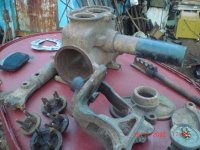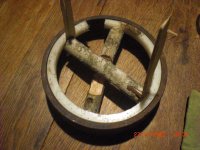magneticanomaly
Titanium
- Joined
- Mar 22, 2007
- Location
- On Elk Mountain, West Virginia, USA
I am overhauling an old FH Myers double-acting hand pump, 5" bore and slightly longer stroke, to pump used fryer oil from a receiving ("dirty") tank through a filter to a ready-to-use ("clean") tank. Not expecting clean enough to fry more taters, just to burn in Diesel engines.
Will be making a new stainless-steel piston-rod (13/16" diam with 14TPI on ends, to fit the tapped end of the cast rack, and nuts to hold piston on.. Will bore out and single-point 3/4-16 nuts to 13/16-14
The piston I removed looked like a piece of heavy conveyor belting between washers. Judging by the cast-iron washers and spacer, I guess originally it had a pair of leather cups.
Some years ago I rebuilt a piston-type motor-driven water pump with about a 3" bore, and found new urethane cups for it. I cannot now find a source...scores of Google hits, all for bicycle-pump-sized leather cups. Can anyone here recommend a source for wide variety of sizes of pump cups...leather OR synthetic?
Of course, a pump CUP usually acts as a check-valve as well as a seal. So for a DA pump, you either need two, or a bi-directional seal.
After soaking some leather and scratching around for something to make forming dies from, to make a pair of leather cups, I decided it would be no more work to make a solid UHMWPE piston, with a piston ring.
Rather than trepanning a ring out of the same 1 1/2" thick plate I will be making the piston out of, I cut a 1/2" wide strip out of some 1/2" plate, thinking to warm and bend it into a ring.
I first forced it cold, with some worry I might break it, into a little scrap of 8" ID pipe...of course the ends stayed straight, so I clamped them, and set the whole on the wood-stove to warm and take the set. My Harbor Freight temp gun said the pipe got to about 80 deg C. After a few hours I took it out and it was no longer straight, but neither did it have an 8" circular O.D.
So I forced it, still warm, into a 6" ID spool, again clamped the ends, and decided I needed more heat. I contemplated asking here, but did not want a jaunt into Computerland to eat another chunk of my day.
I set the 6" ring on the woodstove, and watched the temp with my temp gun. Saw litle if any change. "Fingernail hardness" did not seem to change at 130, 140 deg C. I saw 150..and..a tiny gleaming meniscus against the steel?
Snatched it off the heat....The ring is indeed now formed to 6" OD, with slightly variable radial thickness due to the melting. I will leave it and cut half-lap ends to fit the 5" bore..
But apparently UHMWPE, although it will creep even at room-temp, does not get noticeably soft before it melts...Or did I miss something?
Is there a commercial source for plastic piston rings? I found some from IGUS, but they only go up to 70mm, are radially very thin, and expensive!
Any recommendations for an adhesive to glue leather or rubber (what kind?) to the valves, for service in vegetable oil?
Photos of the pump will follow
Will be making a new stainless-steel piston-rod (13/16" diam with 14TPI on ends, to fit the tapped end of the cast rack, and nuts to hold piston on.. Will bore out and single-point 3/4-16 nuts to 13/16-14
The piston I removed looked like a piece of heavy conveyor belting between washers. Judging by the cast-iron washers and spacer, I guess originally it had a pair of leather cups.
Some years ago I rebuilt a piston-type motor-driven water pump with about a 3" bore, and found new urethane cups for it. I cannot now find a source...scores of Google hits, all for bicycle-pump-sized leather cups. Can anyone here recommend a source for wide variety of sizes of pump cups...leather OR synthetic?
Of course, a pump CUP usually acts as a check-valve as well as a seal. So for a DA pump, you either need two, or a bi-directional seal.
After soaking some leather and scratching around for something to make forming dies from, to make a pair of leather cups, I decided it would be no more work to make a solid UHMWPE piston, with a piston ring.
Rather than trepanning a ring out of the same 1 1/2" thick plate I will be making the piston out of, I cut a 1/2" wide strip out of some 1/2" plate, thinking to warm and bend it into a ring.
I first forced it cold, with some worry I might break it, into a little scrap of 8" ID pipe...of course the ends stayed straight, so I clamped them, and set the whole on the wood-stove to warm and take the set. My Harbor Freight temp gun said the pipe got to about 80 deg C. After a few hours I took it out and it was no longer straight, but neither did it have an 8" circular O.D.
So I forced it, still warm, into a 6" ID spool, again clamped the ends, and decided I needed more heat. I contemplated asking here, but did not want a jaunt into Computerland to eat another chunk of my day.
I set the 6" ring on the woodstove, and watched the temp with my temp gun. Saw litle if any change. "Fingernail hardness" did not seem to change at 130, 140 deg C. I saw 150..and..a tiny gleaming meniscus against the steel?
Snatched it off the heat....The ring is indeed now formed to 6" OD, with slightly variable radial thickness due to the melting. I will leave it and cut half-lap ends to fit the 5" bore..
But apparently UHMWPE, although it will creep even at room-temp, does not get noticeably soft before it melts...Or did I miss something?
Is there a commercial source for plastic piston rings? I found some from IGUS, but they only go up to 70mm, are radially very thin, and expensive!
Any recommendations for an adhesive to glue leather or rubber (what kind?) to the valves, for service in vegetable oil?
Photos of the pump will follow




